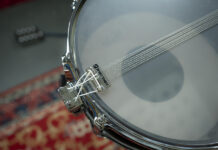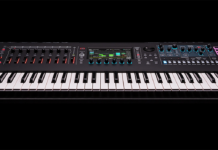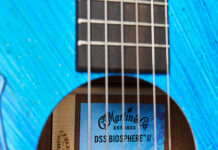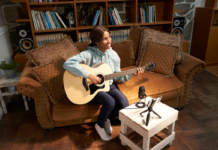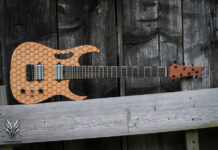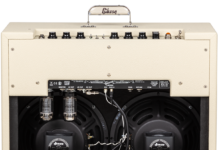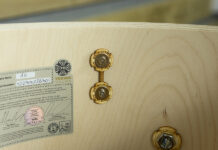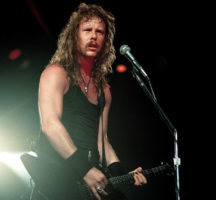
The Secrets Behind James Hetfield's Guitar Sound on Metallica's "Sad But True"
Finding out what gear guitarists use isn’t a problem. Most players will gladly recite a list of their favorite guitars and equipment when asked, especially if they have signature model products. If they won’t, there’s usually a good chance that somebody somewhere has at least snapped a photo or two of their guitars and live rigs.
The bigger challenge is finding out how most guitarists use their gear. It’s not the fault of guitar journalists or the artists themselves—cataloging every single guitar played and amp or effect setting used can be a tedious, laborious, time-intensive affair, and many guitarists can’t remember all of the details (that’s why they pay their guitar techs big bucks). I personally can’t remember every knob on certain amps I own, let alone what my exact favorite settings are.
To help you figure out how to create the guitar tones of several iconic songs, we’ve dug deep into research mode, combing old interviews and meticulously examining stage and studio photos from the appropriate eras. I then dug into my personal gear collection of over 100 guitars, 75 amps and 400 pedals and rack processors to replicate those sounds. If I didn’t have particular pieces of gear, I used items like Fractal Audio’s Axe-Fx II XL+ and AX8 (extremely helpful), a Line 6 POD HD500X and various iPad apps, including Positive Grid’s Bias Series and IK Multimedia’s AmpliTube Series.
Much of the original gear used to record these songs is well known, and as a result many of these items are very expensive, if you can even find them. For those of you with limited funds, we’ve also put together more affordable alternative rigs that should provide most of the core elements of these tones. If you want it all, the most affordable alternative may actually be Fractal’s AX8 and a great guitar or two of your personal preference.
Because control markings and layout styles are inconsistent, I’ve listed all settings from 0–10 where 0 is completely off, 10 is all the way up and 5 is exactly in the middle. Keep in mind that the sound of even the same guitars and amp models can often vary dramatically, especially with vintage gear more than 30 years old. If the recommended settings don’t sound quite right, tweak them as you see fit. These settings worked best with my rigs and should get you very close, but variables such as a guitar’s tone woods and pickups can make a difference. Pedals are listed in the order that they should be chained together in series from the guitar to the amp.
Also keep in mind that all of the examples are studio recordings, so the sounds may not be ideal for live performance. Other important elements like the mics, outboard gear and mixing console settings used in the studio while tracking, mixing and mastering can affect the overall tone, so these sounds may not completely match the final product you hear on a record. However, we hope you’ll find that our settings get you most of the way there and inspire you to come up with your own signature sounds to influence new generations.
“SAD BUT TRUE”
Metallica, Black Album (1991)
Guitarist: James Hetfield (rhythm part only)
What’s genuinely sad but true is that you’ll need to spend a fortune if you want to duplicate James Hetfield’s monstrous rhythm guitar tone on this track with a rig identical to what he originally used. And that doesn’t even include the studio, its equipment and the prodigious talents of producer Bob Rock and engineers Randy Staub and Mike Tacci. Here we can cover only about 60 percent of what went into crafting Hetfield’s sound, and even then we need to speculate, as the details still remain closely guarded secrets.
Hetfield’s rhythm guitar part is composed of numerous layers of tracks recorded through different amps and cabinets (including overdubs of individual amps dialed to different tones), various mics in different positions and outboard equalization and compression. The core of Hetfield’s sound is a mid-Eighties Mesa/Boogie Mark IIC++ (the extra plus denotes a Mesa modification), most likely with a pair of Aphex EQF-2 EQs and an Aphex CX-1 Compressor/Expander in the effects loop. The Mesa’s five-band graphic EQ—in a scooped mid “V” configuration—plays a key role, but the Aphex EQs further sculpt the tone, particularly by cutting 1.2kHz (this frequency cut was also the secret to Dimebag Darrell’s rhythm tone). Marshall amps strategically restored some of the midrange sculpted out of the Mesas.
Further depth and texture was added by overdubbing a Jerry Jones baritone tuned an octave lower than the guitar, while additional overdubs consisted solely of muted string “chuks” to enhance the percussiveness of the attack. These tracks were all meticulously blended with Jason Newsted’s tight unison bass line to create a massive riff.
ORIGINAL GEAR
GUITARS: ESP MX-220 (black finish) with EMG 81 (bridge) and 60 (neck) pickups (bridge pickup), Jerry Jones Danelectro Longhorn baritone copy (bridge pickup)
AMPS: Mesa/Boogie Mark IIC++ (Volume 1: 9.5, Treble: 5/pull shift, Bass: 2, Middle: 0, Master 1: 4/pull deep, Lead Drive: 6/pull lead, Lead Master: 4, Presence: 3, Graphic EQ: 80: +2, 240: 0, 750: -12, 2200: 0, 6600: +3), modified Marshall JCM800 (settings unknown), Mesa/Boogie Mark IV (settings unknown), ADA MP-1 preamp, Mesa/Boogie Strategy 400 power amp
CABINETS: various Marshall 1960B 4x12s with Celestion Vintage 30 speakers
EFFECTS/PROCESSORS: (connected to amp effects loop) Two Aphex EQF-2 EQs (EQ1: 4.2kHz shelving/+6, 1.2kHz/-6, 120Hz shelving/+4, high-pass filter 100Hz; EQ2: 6kHz shelving/+6, 900Hz/-6, 240Hz peaking/-4), Aphex CX-1 Compressor/Expander (settings unknown)
STRINGS/TUNING: Ernie Ball Power Slinky .011–.048/ D standard (DGCFAD)
PICK: Dunlop Tortex .88mm
GET THE SOUND, CHEAP(ER)!
• ESP LTD EX-401
• Mesa/Boogie Recto-Verb 25 combo
• Mesa/Boogie Boogie Five-Band Graphic EQ pedal
TONE TIP
Place the Graphic EQ pedal in the amp’s effects loop for the best-sounding and most dramatic EQ sweep.
Source: www.guitarworld.com

